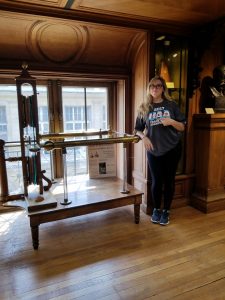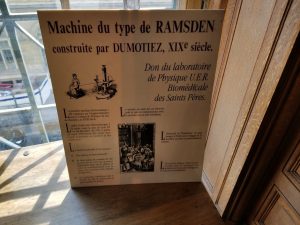My class visited the Museum of the History of Medicine in Paris. This museum contained an abundance of medical and surgical tools that were used in the past. Some of the collections for this museum were first put together in the 18th century! I had quite the experience and want to share a little more about what I saw there!

I saw various novel technologies that sought to improve medicine and surgery. In the beginning of the tour, we saw saws intended for amputation, drills meant for piercing the skull, and many more intriguing contraptions. To my surprise, some of the tools that were created in the 18th century are still being used today in the operating rooms. One apparatus that is no longer used but I found the most interesting was called the “Machine du type de Ramsden” which delivered static electricity as a treatment for nerve diseases, neuralgia and rheumatic diseases. This machine worked by creating frictional electricity and producing a fluid that came off the machine and was described to be soothing. This machine was used for quite a few years as a treatment for these various diseases. I find it so interesting how technology has evolved over the years. For example, Neuralgia is a condition of the peripheral nervous system that can result in acute pain in certain areas of the body which may range from a pricking pain to an electric shock sensation. Now a days, treatments involving anticonvulsant drugs that are used to block or lessen the effects of pain signals to the brain are utilized and have proven to be beneficial (Filatova, Turovskaya, Alekseeva 2017). Not only in prescription medication used to treat these conditions, but in most recent years, brain stimulation has also been introduced as a possible treatment (Pereira and Aziz 2014).
It is interesting to note how treatments for such diseases have shifted from hands on treatment involving static electricity to prescription medication and seems to be going in the direction of brain stimulation. I loved being able to see past inventions and how some of apparatuses are similar to ones currently. Scientists and researchers in the 18th century thought of curing some neuropathic pain diseases with electric shock and researchers are currently falling back to similar ideas with brain stimulation in which specific areas of the brain are activated. I love being able to connect my neuroscience background to the various places we visit!
References:
Filatova, E., Turovskaya, E., & Alekseeva, L. (2017). Evaluation of the efficacy of pregabalin in the therapy of chronic pain in patients with knee osteoarthritis. Terapevticheskii Arkhiv, 89(12), 81. doi: 10.17116/terarkh2017891281-85
Pereira, E., & Aziz, T. (2014). Neuropathic Pain and Deep Brain Stimulation. Neurotherapeutics, 11(3), 496-507. doi: 10.1007/s13311-014-0278-x

the machine presented here consists of:
a tray and a crank handle;
two pairs of leather-covered horsehair cushions, which press the plate slightly between them and are in contact with the earth.;
The cushions are coated with gold oxide
a metal conductor insulates and ends on the side of the plateau by a large number of points
